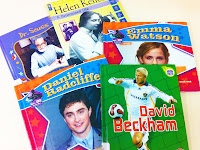Some fairytales you may have heard of as a child:
Cinderella, Snow White, Little Red Riding Hood, The Princess and the Pea
Vocabulary
Classic- (noun) A work of art with recognized value.
Imaginary- (adjective) Existing only in one's mind.
Enchanting- (adjective) Very charming or attractive.
Conflict- (noun) A serious disagreement.
Triumph- (noun) A great victory or achievement.
Traditional- (adjective) An inherited or custom pattern of thought, action, or behavior.
Generation- (noun) A group of people born and living during the same time.
Character- (noun) Qualities in a person that make them different.
Hero- (noun) A person who is admired for his or her courage.
Face- (verb) To confront or deal with.
Vocabulary Activity
Please unscramble the following words from our vocabulary list:
1. Crcatehra
2. roHe
3. inGoatneer
4. aecF
5. igrIanmya
6. Cailcss
7. nnniEgchat
8. oltainTardi
9. upihTmr
10. lnofCcit
Grammar Point
Character and Face are both considered to be homophones. A homophone is two or more words that have the same pronunciation but different meanings. We used character in this post to describe the qualities in a person, but we also know that character could be a person or animal in a novel. We used face in this post to describe what a hero in a story has to confront or deal with, but we know that face also means the front of a persons head. Knowing this, please list 5 other homophones.



